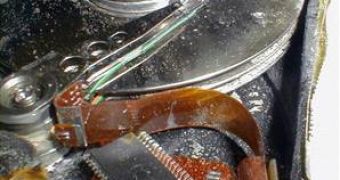On the 1st of February 2003, the space shuttle Columbia re-entered Earth's atmosphere while severely damaged to the left wing. The intense heat generated by the friction with the air eventually weakened the structural integrity of the vehicle and determined its disintegration, killing the crew of seven it was carrying on board. Most of the pieces which resulted in the breakup burned over the sky of Texas, while some reached ground intact.
Amongst these, there is one 340 megabytes hard drive, half written, carrying the data recorded from an experiment conducted into space by the crew of Columbia. The electronic device was retrieved shortly after the incident, and although partially damaged, it was sent to Kroll Ontrack Inc., a NASA contractor specialized in recovering data.
"When we got it, it was two hunks of metal stuck together. We couldn't even tell it was a hard drive. It was burned and the edges were melted. It looked pretty bad at first glance, but we always give it a shot," said Kroll Ontrack Inc. engineers Jon Edwards. The hard drive contained critical data from a scientific experiment studying the properties of xenon liquid in weightless environments. Part of the data was sent back to Earth before the re-entry, but much still remained on board Columbia.
In addition to being melted beyond recognition, the plastic seals of the drive were also severely damaged, leaving there different particles which could have easily scratched the disk. The metal disks themselves were only partially damaged by the extreme heat, towards the outermost regions. Usually, operating systems write information on hard drives randomly, scattering it all over the disk.
But the computer which was used to record the data had only a disk operating system - extremely old, even for the year 2003 - which wrote data in an orderly fashion from the center of the disk towards the outer most regions, where the damage occurred. Edwards had a struck of luck and was able to retrieve 99 percent of the information recorded during the experiment.
In fact, the data was recovered in only two days, but it took nearly five years to process it in order to reveal the findings of the experiment. Other two hard drives on board Columbia, however, were not that fortunate and the information they were carrying was lost forever.

 14 DAY TRIAL //
14 DAY TRIAL // 
